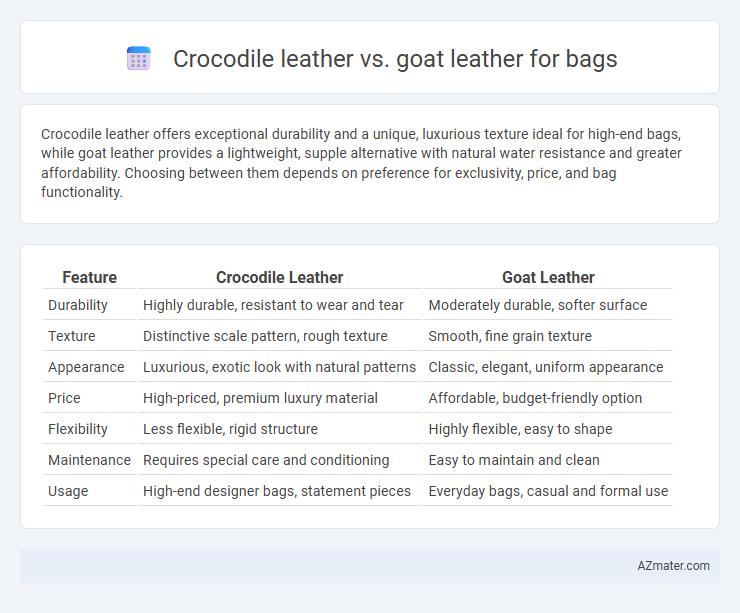Crocodile leather offers exceptional durability and a unique, luxurious texture ideal for high-end bags, while goat leather provides a lightweight, supple alternative with natural water resistance and greater affordability. Choosing between them depends on preference for exclusivity, price, and bag functionality.
Table of Comparison
| Feature | Crocodile Leather | Goat Leather |
|---|---|---|
| Durability | Highly durable, resistant to wear and tear | Moderately durable, softer surface |
| Texture | Distinctive scale pattern, rough texture | Smooth, fine grain texture |
| Appearance | Luxurious, exotic look with natural patterns | Classic, elegant, uniform appearance |
| Price | High-priced, premium luxury material | Affordable, budget-friendly option |
| Flexibility | Less flexible, rigid structure | Highly flexible, easy to shape |
| Maintenance | Requires special care and conditioning | Easy to maintain and clean |
| Usage | High-end designer bags, statement pieces | Everyday bags, casual and formal use |
Overview of Crocodile Leather and Goat Leather
Crocodile leather is renowned for its durability, distinctive scale patterns, and high-end luxury appeal, making it a premium choice for exclusive bags with a unique texture and natural sheen. Goat leather, by contrast, offers a softer, more flexible texture with fine grain and lightweight qualities, providing comfort and resilience ideal for everyday bags. Both types vary significantly in price and maintenance, with crocodile leather requiring more care to preserve its appearance, while goat leather is more resistant to scratches and easier to handle.
Appearance and Texture Differences
Crocodile leather features a distinctive, bold pattern with large, irregular scales that convey luxury and exclusivity, while goat leather exhibits a more uniform grain with a fine, pebbled texture, offering a subtle and natural look. The surface of crocodile leather is glossy and rigid, providing a structured form that enhances the bag's visual impact, whereas goat leather is softer and more pliable, allowing for flexibility and comfort in daily use. These contrasting textures and patterns create unique aesthetic appeals, with crocodile leather emphasizing opulence and goat leather highlighting practicality and understated elegance.
Durability and Longevity
Crocodile leather is renowned for its exceptional durability and longevity due to its dense fiber structure and natural resistance to wear, making it ideal for high-end, long-lasting bags. Goat leather, while less durable than crocodile leather, offers impressive strength and flexibility, providing a balance between durability and lightweight comfort. Bags crafted from crocodile leather typically maintain their structural integrity and aesthetic appeal longer than those made from goat leather, especially with proper care.
Weight and Comfort
Crocodile leather is significantly heavier and denser than goat leather, making bags crafted from it feel more substantial and luxurious but potentially less comfortable for extended use. Goat leather offers a lighter weight and superior flexibility, enhancing comfort and ease of carrying, especially in everyday or casual bag designs. Choosing between the two depends on balancing the premium, durable texture of crocodile leather against the breathable, soft nature of goat leather for optimal comfort.
Price Comparison
Crocodile leather bags are significantly more expensive than goat leather bags due to the rarity and intricate processing involved in crocodile skin. While goat leather offers affordability and durability, crocodile leather commands premium prices, often ranging from five to ten times higher, reflecting its luxury status. The price gap is influenced by factors such as durability, texture exclusivity, and the labor-intensive tanning process unique to crocodile leather.
Maintenance and Care Requirements
Crocodile leather requires specialized care, including regular conditioning with pH-balanced products to maintain its natural oils and prevent cracking, while avoiding prolonged exposure to water and direct sunlight to preserve its texture and sheen. Goat leather, known for its softness and durability, demands less intensive maintenance but benefits from occasional cleaning and moisturizing to prevent drying and maintain its suppleness. Both types should be stored in breathable bags away from humidity and heat to prolong their lifespan and keep their appearance intact.
Water and Stain Resistance
Crocodile leather offers exceptional water and stain resistance due to its dense scale structure and natural oils, making it ideal for high-end, durable bags. Goat leather is naturally water-resistant with a supple texture but requires protective treatments to enhance stain resistance for everyday use. Both materials benefit from proper care, yet crocodile leather inherently provides superior protection against moisture and stains.
Ethical and Sustainability Concerns
Crocodile leather production raises significant ethical concerns due to the impact on wild populations and the often inhumane farming practices involved. Goat leather, sourced from animals primarily raised for meat and dairy, offers a more sustainable alternative with lower environmental footprints, including reduced water usage and greenhouse gas emissions. Choosing goat leather supports ethical fashion initiatives by promoting responsible livestock management and reducing reliance on endangered species.
Fashion Appeal and Status Symbol
Crocodile leather is highly prized in the fashion industry for its distinctive, luxurious texture and exclusivity, making it a powerful status symbol often associated with wealth and sophistication. Goat leather, while durable and supple, offers a more understated elegance that appeals to consumers valuing practicality and subtlety over flashy opulence. The rarity and price of crocodile leather elevate its bags to luxury items, whereas goat leather bags cater to both high-end and everyday fashion markets with versatile style and accessibility.
Choosing the Right Leather for Your Bag
Crocodile leather offers unmatched durability, distinctive texture, and a luxurious appearance ideal for high-end bags, while goat leather provides a lightweight, flexible option with a soft grain and excellent breathability. When choosing the right leather for your bag, consider the balance between durability, maintenance requirements, and aesthetic preferences, as crocodile leather demands more care and investment but delivers exceptional prestige. Goat leather suits those seeking affordability and comfort without sacrificing style, making it perfect for everyday bags with a casual yet refined look.

Infographic: Crocodile leather vs Goat leather for Bag
 azmater.com
azmater.com